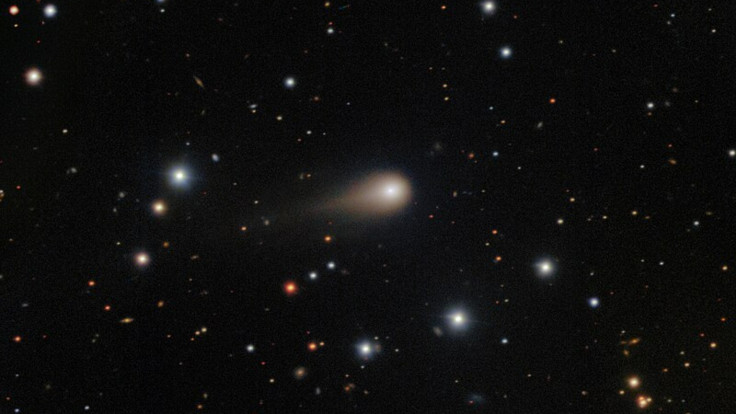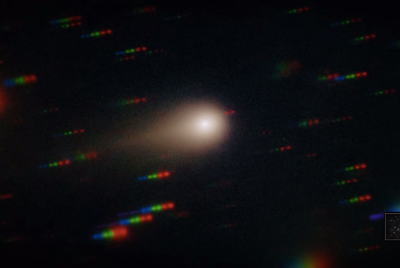New 3I/ATLAS Image Sparks Outrage And Awe As 'Dead' Interstellar Object Roars Back To Life
High-resolution images and stacked exposures reveal sunward jets and an extended anti-tail, intensifying global study of the interstellar visitor.

A previously 'vanished' interstellar comet has stunned astronomers worldwide by reappearing with a longer, brighter, and more structured tail, reigniting curiosity about the mysterious object's composition and behaviour.
Just weeks after its tail seemed to disappear entirely, 3I/ATLAS, the third confirmed interstellar object, has revealed a strikingly luminous ion tail and complex dust structures. Captured in a composite image on 10 November 2025, these observations were made under challenging conditions, with the comet just 14 degrees above the horizon and a 61 per cent illuminated Moon interfering. Yet the images show remarkable clarity and detail. Researchers and amateur astronomers alike are scrambling to understand the mechanisms driving this dramatic transformation.
Dramatic Reappearance Captured By Virtual Telescope Project
The latest high-resolution image of 3I/ATLAS was compiled from 18 long-exposure frames, released by the Virtual Telescope Project in Italy. These reveal not only a well-defined ion tail stretching nearly 0.7 degrees across the sky but also a faint anti-tail pointing towards the Sun, likely caused by perspective effects.
Dr Gianluca Masi, head of the Virtual Telescope Project, said: 'We imaged the interstellar comet again, recording a much more developed ion tail. Each observation shows it better and better.' The tail is created by solar ultraviolet radiation ionising gases sublimating from the comet's nucleus. These charged particles are pushed away from the Sun by the solar wind, forming a distinct, straight ion tail separate from the dust tail.
The composite image highlights a bright central core, a compact coma surrounding the nucleus, and multiple jets extending from the surface. According to the Virtual Telescope Project, the renewed activity indicates intensified sublimation, suggesting a complex mix of volatile materials within the comet.
Earlier Disappearance Raised Questions About Composition
The sudden disappearance of 3I/ATLAS's tail earlier this year puzzled astronomers, as tail formation is typically a predictable response when icy materials sublimate near the Sun. Harvard astrophysicist Avi Loeb noted that 'nearly 13 per cent of the comet's mass should appear as a tail', yet no such feature was initially visible.
This absence led to speculation that the comet might have fragmented or possessed unusual material properties. The reappearance of the tail challenges prior assumptions, illustrating that interstellar objects can behave unpredictably when entering a solar system.
Independent observers, including amateur astronomers Michael Buechner and Frank Niebling, produced stacked images on 9 November 2025 that further revealed large-scale structure in the comet's dust environment. Their observations, compiled from multiple short exposures, showed anti-tails and sunward jets, offering additional confirmation of the comet's renewed activity. While direct social-media posts from the astronomers are limited, these images have circulated via astronomy forums and citizen-science platforms, providing key evidence for ongoing analysis.
Scientific Significance Of 3I/ATLAS
3I/ATLAS is only the third confirmed interstellar object, following 1I/'Oumuamua and 2I/Borisov, making it an invaluable source of information about material formed around distant stars. The comet carries chemical signatures and physical properties from another planetary system, providing a rare opportunity to study extrasolar formation conditions.
Mark Norris, professor at the University of Central Lancashire, said: 'If confirmed, it will be the third known interstellar object, providing more evidence that such interstellar wanderers are relatively common in our galaxy.' Observing the evolution of the comet's tail and coma allows scientists to understand how volatile-rich interstellar bodies respond to solar radiation, crucial data for planetary science and astrochemistry.
The comet is projected to continue its path toward an encounter with Jupiter in March 2026, giving researchers an extended window to track its behaviour. Coordinated observations across professional and amateur observatories are underway to measure the nucleus size, rotation, and outgassing patterns.
Dr Masi emphasised the importance of rigorous observation and analysis: 'The comet behaves like a living laboratory. Each new image allows us to study the processes of interstellar bodies in real time, but we must remain cautious and evidence-based in our conclusions.'
The images captured in early November have provided not only stunning visuals but also crucial datasets for the astrophysical community. As the comet continues its journey through the Solar System, its behaviour may yield new insights into the diversity and dynamics of material originating beyond our own star system.
The dramatic resurgence of 3I/ATLAS's tail underscores the unpredictable nature of interstellar visitors and the value of continued observation, offering a rare glimpse into the chemistry and physics of objects formed in distant planetary systems.
© Copyright IBTimes 2025. All rights reserved.




















